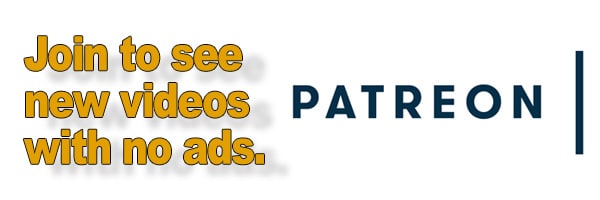As an Amazon Associate DcSoundOp earns from qualifying purchases.
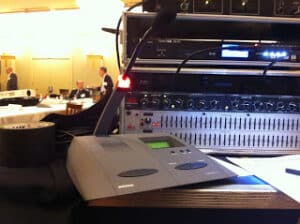
Over the years working here in DC, I’ve spent more then my share of time working with both big business clients as well as government and political clients. Often times in this town, the line between the two can become blurred, with business clients hosting political style events and vise versa. The myriad of challenges that are presented to an A/V provider when producing some of these types of events can often leave you searching for solutions to problems that often times shouldn’t exist in the first place.
One such style of event that we deal with a lot here, is the round table discussion. Years ago, if there was to be any A/V support for a round table discussion, it was relatively simple, microphones placed appropriately to capture the discussion to a recording device, perhaps an audio feed to a camera and the odd projector or two to handle on the visual end of things. The venerable Shure AutoMixers were all you typically needed to get solid audio mixed correctly to tape, if you needed more then four microphones, you simply chained two auto mixers together and you were off to the races. You might be recording to a cassette deck in those days, a beta cam deck or maybe even a simple ISDN feed to an offsite location for recording or broadcast.
Today I’m sitting here operating what I would call by today’s (2012) standards, a VERY simple round table discussion… Hosted by a commercial business (one we’re all familiar with) and featuring discussion panels made-up of politicians… So let’s take a look at what has changed on our end of the job.
First we’ll look at our round-table, which more often then not in this town ends up being more of a large rectangle. At one of the short ends of the rectangle, we have seating for 4 panelists (the politicians) with the other short end being populated by the 4 corporate talking heads who are directing traffic and spurring on the discussion when needed. So, eight microphones so far, not too bad. Our Shure auto mixers might come in handy after all…
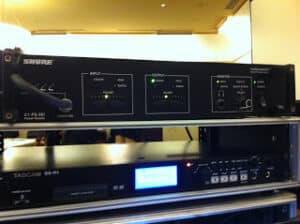
Today we are also tasked here with recording audio and video of the day for later web distribution. These feeds include a program feed to a local solid state (CF Card) recording deck [Tascam SS-R1], a program feed to our primary HD Camera, along with another camera feed that includes the program material along with ambient audio from the viewing gallery. So, obviously we need to add some room (ambient) microphones to our input list. Whew… I think that’s everything we’ve got going on here today. So how do we keep 38 inputs under control, during a heated round-table discussion, while juggling audio and video and making sure all of our recordings are broadcast quality, with only one A/V tech and a camera operator on hand?The longer sides of the rectangle today though each seat 15 additional participants, adding another 30 voices to the conversation. Behind those additional people (set back 6′ or so) on the long sides are another two rows of chairs of gallery seating for on-lookers and observers to the discussion. We also have a 14′ projection screen on one end, with a lectern positioned along side for stand-up and visual presentations. I won’t get into all of the video needs of the day here, but needless to say, I am setup to handle and project almost any type of visual media that might come our way. So we can add a lectern microphone along with an audio feed from our projection media source to our input list.
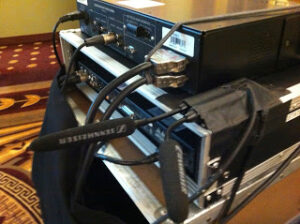
The solution that we call upon time and time again, is the SHURE ConferenceONE System. This is a modern system that was first introduced in (2003) and features an incarnation of the SHURE IntelliMix Automatic Mixing technology to actively manage up to 60 microphones at any given time. The system is setup with a base station [ Power Supply Unit C1-PS 30s] this unit provides power, interconnect and control, but is not a working station in the system. Next we have a Chairman’s Console [C1-Cs] (this is typically the unit that I keep @ my control position. After that, you have the Delegate Consoles [C1-Ds] that are distributed around the tables.
The delegate consoles can be arranged in a few different configurations, as long as you follow a few basic rules of deployment. The consoles are connected to one another with a clever locking connector that Shure calls MiniCon. All of the MiniCon cable ends are Male, while all of the panel mount sockets are female, allowing the system to be deployed quickly without concern for cable direction. You can connect up to 15 stations to each of the power supply’s MiniCon outputs, and up to thirty stations total on each system (each C2-PS 30s) before you have to cascade additional power supply units. Each of the delegate consoles feature a fold-out telescoping gooseneck microphone, an “on-air” light, a push-to-talk button, a speaker to amplify the other participants, along with a volume control and even an 1/8″ headphone output jack for personal monitoring!
What the ConferenceOne system offers us is a simple, consistent and reliable way to keep up with the conversation in a large round-table setting. The system can be deployed in a push-to-talk arrangement, where each end user must activate their own mic (this is what I used for this event) or it can be deployed using only it’s auto-mix technology to direct the conversation. When dealing with a controlled panel discussion with an audience, I want to keep the banter a bit tighter then I would in a closed board-room situation, so I choose the push-to-talk mode to allow the directors to see a visual (RED LIGHT) on the station of whomever wishes to contribute to the conversation next. By having the Chairman’s station at my control position, I can also control the chaos, by setting a max number of microphones (5 in the case) that can be active at any given time, along with having the ability to turn off excess microphones if needed.
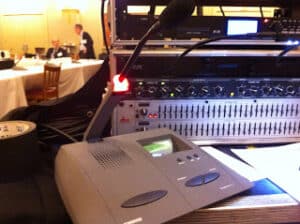
Once the ConferenceOne system is deployed and working properly, I simply take the mono-balanced XLR output from the C2-PS30s base station, and connect that to my mixing console of choice. Now, I have control over my entire conference system on a single channel of my console. With the Lectern microphone, the video playback, and ambient room microphones taking up only a few channels, the show now becomes quite efficient to control and easy to manage. I was able to assign the necessary sources to the various recording feeds, and was able to amplify the ConferenceOne system through some small zone speakers to ensure proper coverage of those listening in the gallery seating along the walls.
When properly deployed, the system can feel very natural and can operate with a very low potential for feedback issues. In these situations, I have found it works best to keep the volume on the individual stations at a low volume, as the speakers in the delegate consoles are not the most robust sounding speakers you’ll ever hear. I then position my zone and fill speakers up above head level and aiming downwards to get the best possible coverage with the lowest amount of overall volume needed. When you get the balance correct, you should be able to walk around to any station or to the lectern microphone and when you speak, it should NOT sound as though there is a big booming PA system in the room. The desired effect should be just enough volume to support your voice, giving it clarity and distributing it to everyone in the space evenly. The key here is to go for coverage, keeping the volume under control is done by proper placement of your speakers. I find that once I have made EQ adjustments on the (voice output bus) of my console to get the lectern microphone (Crown LM300 in this case) sitting comfortably in the room, assigning the ConferenceOne system to this same bus requires little additional attention to feedback suppression. The Shure station microphones do seem to need a bit more reduction around 4kHz then the Crown LM300 does, but only by a small margin.
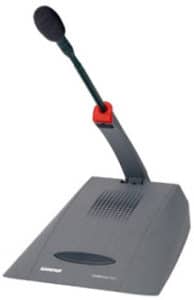
At the end of the day, the ConferenceOne system is a great tool that you can put to use in challenging environments, solving challenging problems and helping you produce high-quality events without breaking the bank. These systems, although not cheap, can be typically found and rented from regional providers around the country. It is also well worth noting, that although the Shure ConferenceOne system is very common and popular, it is currently not in production from Shure. Sennheiser and a few other manufacturers make similar products, that I will be looking to try more in the future, as the Shure technology is becoming outdated. Unfortunately, the Shure system seems to be the most readily available in the DC area. As I have the opportunity to work with these systems more, I will be looking to see how the currently available systems compare to the now discontinued Shure product. No matter the manufacturer, the next time you’re scratching your head trying to figure out how to approach a corporate gig, give a look at this type of system, you may be surprised how well they work.
Amazon and the Amazon logo are trademarks of Amazon.com, Inc, or its affiliates.
